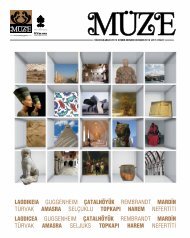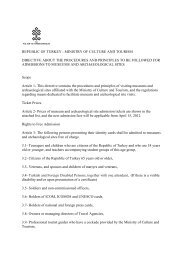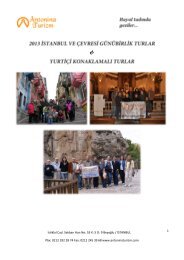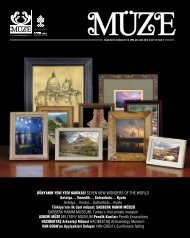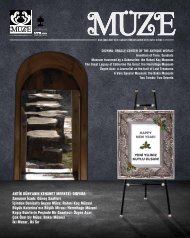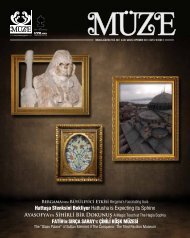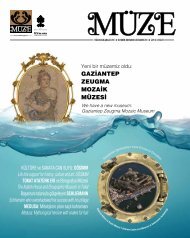TÃRK MÃZECÄ°LÄ°ÄÄ°NDE YENÄ° DÃNEM
TÃRK MÃZECÄ°LÄ°ÄÄ°NDE YENÄ° DÃNEM
TÃRK MÃZECÄ°LÄ°ÄÄ°NDE YENÄ° DÃNEM
Create successful ePaper yourself
Turn your PDF publications into a flip-book with our unique Google optimized e-Paper software.
adını da, Lenin’e ithafen bizzat kendisi koyar: ‘Sebastes Lenini’... Marmara,Adalar ve özellikle İstanbul Boğazı, balık konusunda böyle ilginç anekdotlarlabinlerce yılı kucaklayan bir mirasa sahiptir. O mirasın en gözde balığı ise, birzamanlar Boğaz sularında sürüler halinde görülen palamuttur.Palamut, hem düzgün şekliyle balıkların ‘yakışıklısı’ sayıldığı hem de bolluğuyüzünden İstanbul’un en eski uygarlıklarından günümüze ‘baş tacı’ edilmiştir.Byzantion, kentin simgesi olarak palamutu seçmiş. MS 2’nci yüzyılda sikkelerininpalamut resmini nakşetmiş. Sonrasında da kimi Bizans paralarının üzerinde,krallarla birlikte onun resmi yer almış.Did you know that Trotsky put on alert Stalin and the whole Soviet nomenclaturabecause of a fish he collected at the Prince Islands’ shore during his years of exile inİstanbul? Or why a certain kind of fish of the Marmara Sea is called Prophet’s fish?Fish is indeed one the most common figures encountered in archaeological remains.So much so that it figures on Byzantine coins. Archaeology keeps the memoryarchives of the world, presents us with the codes of traces, thousands of years old.Those codes showing us that different cultures having flourished at different cornersof the world without direct contact with each other, were using similar signs andsymbols for communication purposes. For instance, the eye design... Or, a hand,having different meanings when pictured in different positions... And, one of theoldest symbols: the fish! From China to Egypt, from Mesopotamia to the cold shoresof the North, the fish meant abundance and fertility, because it is one of thebiological assets nature is offering with ample generosity. It also carries somemystery with itself because it keeps living in the darkness of deep waters. Maybe thisis why fish was the symbol of reincarnation in ancient Egypt. Actually, fish has alsobeen the symbol of Christianity and used as such for several centuries. Amongdifferent tales on how fish was related to Christianity, Christians attribute priority tothe belief that Jesus Christ saved five thousand people from hunger by feeding themwith fish and bread. In fact, the early Christians were using fish drawings on theground as a code to recognize each other discreetly, thus avoiding persecution. Thisis probably why the people of Marmara used to call the john dory fish, whose facereminds us of a human face with a tragic expression, Prophet’s fish or Saint Peter’sfish. Again, Trotsky’s rockfish story is one of the most amazing and ironic episodes ofthis unusual historical account on fish. End of the twenties, beginning of the thirties,one of the leading personalities of the Russian Revolution, Trotsky, had to flee theSoviet Union due to his disagreement with Stalin and took refuge in Turkey, namelyin İstanbul’s Prince Islands. His exile years were focused on ideological discussionswith some friends around him and through correspondence with other friends andfoes. But of course, there was time for leisure and Trotsky’s preferred pastime wasfishing. He asked a friend, in a letter, to buy for him some line possibly 200 meterslong for underwater rods used for catching big fish. Apparently it was with this linesent to him from the United States that he collected three specimen of the rockfishwhich provoked big turmoil in Kremlin. Trotsky noted the unusual hammer andsickle pattern, the emblem of the Soviet Communist Party, on the fish’s flanks.Known for his academic work in the field of ichthyology, Trotsky baptized (!) thisrockfish as the Hammer and Sickle Fish. But, since he had to continue to escapefrom Stalin’s secret police still after him, he was unable to finish his scientific study.It was Stalin who later ordered Soviet scientists to follow up on Trotsky’s footstepsto complete the research on the so-called hammer and sickle fish. Finally, adescription of the new rockfish species was published in 1942 by Joseph Stalin in theZoological Journal where he was naming it “Sebastes Lenini” supposedly inremembrance of his predecessor Lenin, the leader of the Bolshevik Revolution.Marmara, the Prince Islands and particularly the Bosporus enjoy a rich heritage insuch fish anecdotes embracing thousands of years. The favourite figure in thisheritage is the one of pelamyd, a fish also called horse mackerel or bonito (in theAtlantic Ocean), which used to cross the Bosporus in earlier years in large schoolsand which became rather rare in recent years. Due to its smooth-shaped body,pelamyd was considered the most ‘handsome’ among fishes. The fact that it wasfound in large quantities in the area, pelamyd was at all times greatly ‘respected’ inİstanbul from the period of the oldest civilizations up to our era. Byzantion chosepelamyd as the city’s emblem and, Byzantine coins were engraved with the pelamydpattern during the 2 nd century A.D. Later, the fish pattern continued to be imprintedon coins along with kings’ pictures.Palamut, yüzyıllar boyuncaİstanbul sofrasında yerinialmış. Kimi zaman, günümüzekadar uzandığı gibi, kömürızgarasında kızartılıp ekmekarası yapılmış. Kimi zamanpişirilip özel soslarla servisedilmiş.Bugünkü lezzet anlayışına hiçuymayabilir; ancak Bizanslılarpalamutun bağırsakları vekanını toprak bir kaba koyar;güneşte bir süre bekletir,sonra üzerine biraz şarap vezeytinyağı ekleyip balığınüzerine dökermiş. Bu özel sosdaha çok zengin sofralarındakullanılırmış ve herhalde odönemde palamut tarifiistense, ilk sırayı bu özel sosalırmış. Dedik ya, günümüzehiç uymayacak bir tarifbu. Ama lezzetin binlerceyıllık yolculuğunda, bugüneküçük de olsa bir iz bırakmış.‘Palamut yahnisi’ buna ilginçbir örnek:Palamut yahnisiYedi bütün soğanı yarımhalkalar halinde doğrayın.5 diş sarımsak ve 1 demetmaydonozu kıyın. 3 havucuda dilim dilim doğrayıp hazırlayın.Soğanı zeytinyağındakavururken, 1 kg. civarındagelen palamutu ayıklayıp kısıkateşte haşlayın. Yumuşadıklarızaman derisini yüzüp beyazetlerini alın. Soğan kavrulunca2 kaşık domates salçasınıekleyin. Üzerine de kalan harcıkoyun ve soteleyin. Damaktadınıza uygun baharatlar vebir miktar suyla, sebzeler yumuşayıncayakadar kaynatın.Sonunda balığın beyaz etinide ekleyip bir taşım dahakaynatın.Yerken de bu toprakların,bu dünyanın bizden öncekisakinlerini düşünün. Bir dininsimgesi sayılan, paralarınüzerinde resmedilen balıkacaba hangi sofralara nasılgelirdi?Ve arkeoloji denilen ‘eskininbilimi’ bugüne ne söylüyor?Bir zamanlarBoğaz’dan sürülerlegeçenpalamutukoruyabildikmi?Balığınkralı palamut,tahtınadönebilecek mi?Pelamyd, on İstanbul’s dinnertables for centuries, sometimesserved standing asgrilled fish sandwich, othertimes being served in moregourmet fashion withsucculent sauces. Byzantinesused to put the bowels andthe blood of the fish in a terracotta pot and kept it underthe sun for a while, thenadded olive oil and wine andused the mixture as a specialdelicacy sauce on fish dishes.This special sauce was usedrather at dinner tables of thewealthy and probablyconstituted the most praisedpelamyd recipe of its time.Perhaps not ideal for ourpalates today, it has neverthelessleft its mark behindthroughout the ages. Thepelamyd ragout or stew ismaybe a good illustration.Pelamyd Stew: Cut sevenwhole onions in half circles.Chop up five cloves of garlicwith one bunch of parsley.Prepare three carrots bycutting them in slices. Whileroasting the onions in oliveoil, boil approximately onekilogramme of cleaned outpelamyd fish on low heat.When they become tender,peel off their skin and take thewhite meat aside. Add twotable spoons of tomato pasteonto the roasted onions andpour the rest of the filling ontop of them and keepsautéing the whole mixture.Boil the vegetables in a littlewater with preferred spicesuntil they soften. At the end,put in the fish white meat andbring the whole one moretime to the boil. It’s ready tobe served. While eating thestew, think about the world’sprevious inhabitants wholived before us. Imagine atwhich dinner tables and inwhat way was served the fish,symbol of a religion, engravedon coins, before our time?Give thought to whatarchaeology, the ‘science ofthe old’ could tell us today.Have we been able topreserve the pelamydcrossing once upona time theBosporus ingenerousshoals?Will theking ofthe fishesbe able toreturn to itsthrone?71



